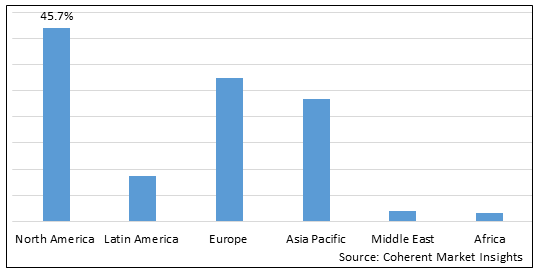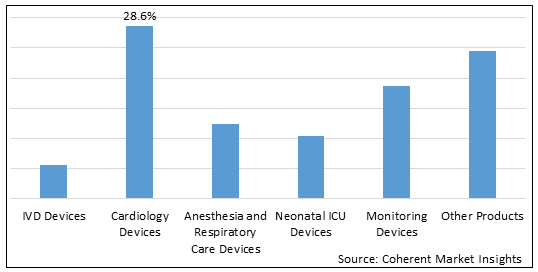The global pediatric medical devices market was valued at US$ 31,726.3 Mn in 2021 and is forecast to reach a value of US$ 57,035.3 Mn by 2028 at a CAGR of 8.7% between 2022 and 2028. The global pediatric medical devices market is experiencing strong growth due to the rising prevalence of chronic diseases among the pediatric population and increase in focus on pediatric healthcare. Moreover, increase in demand for pediatric medical devices and rise in research and development across the globe is expected to boost the growth of the market. However, factors such as pediatric device development challenges and lack of skilled professionals are expected to hamper growth of the global pediatric medical devices market.
Global Pediatric Medical Devices Market: Regional Insights
Based on geography, the pediatric medical devices market is segmented into North America, Latin America, Europe, Asia Pacific, Middle East, and Africa.
Among regions, North America is expected to gain highest share in the market over the forecast period owing to the increasing burden of disease in pediatric populations and increase in focus on pediatric healthcare in the region. For instance, according to the Centers for Disease Control and Prevention (CDC), around 8.4% (or over 6 million) of children in the United States have asthma. Asthma is a chronic disease that has a high morbidity rate and a comparatively low mortality rate overall. Asthma is a serious disease causing wheezing, difficulty breathing, and coughing. Over a lifetime, it can cause permanent lung damage.
Europe is also expected to witness robust growth in the global pediatric medical devices market due to the rising incidence of chronic illnesses in children and increase in awareness among people in this region. For instance, according to the Royal College of Paediatrics and Child Health (the professional body for paediatricians in the U.K.), asthma is the most common long term condition among children and young people, with 1.1 million children currently receiving asthma treatment. Moreover, it continues to be among the top 10 causes of emergency hospital admission for children and young people in the U.K., driving the market growth.
Figure 1. Global Pediatric Medical Devices Market Share (%), by Region, 2022

To learn more about this report, Download Free Sample
Global Pediatric Medical Devices Market Drivers:
High prevalence of chronic diseases to propel market growth
One of the key factors expected to propel the growth of the global pediatric medical devices market over the forecast period is the rising prevalence of chronic diseases among the pediatric population. For instance, according to the UNICEF (an agency of the United Nations), November 2019 report, pneumonia claims the life of a child every 39 seconds on the world. Most of these deaths occurred under the age of two and nearly 153,000 newborns die due to pneumonia within a month of his or her birth. This in turn is driving the growth of the market.
Increase in focus on pediatric healthcare to drive market growth
Another factor which is driving the growth of the global pediatric medical devices market is the increase in focus on pediatric healthcare. For instance, due to the increasing prevalence of chronic diseases among the pediatric population, market players and several governments worldwide are focusing on improving healthcare infrastructure for pediatrics. In May 2021, the Center for Health Care Strategies (CHCS) launched a learning community that will work with 12 leading pediatric practices, a team of six family advisors, and experts in the field from across the nation to advance innovations for providing more equitable and family-focused care.
Global Pediatric Medical Devices Market Opportunities:
Increase in demand for pediatric medical devices worldwide is expected to offer significant growth opportunities for players in the global pediatric medical devices market. For instance, the demand for pediatric medical devices has increased or is increasing due to increasing prevalence of chronic diseases in pediatric population. In February 2022, Masimo announced the U.S. Food and Drug Administration (FDA) clearance of SedLine brain function monitoring for pediatric patients (1-17 years of age) and the SedLine Pediatric EEG Sensor. With this clearance, the potential benefits of SedLine have been expanded to all patients one year old and above in the U.S.
Increase in research and development (R&D) across the globe is expected to offer lucrative growth opportunities for players in the global pediatric medical devices market. For instance, cutting-edge research and advanced technologies have led to the development of numerous innovative medical devices, enabling pediatric patients to live healthier/longer lives. In January 2022, Good Parents raised around US$ 16 million in a Series A funding round that was spearheaded by Vive Collective. Children with diseases such as asthma, diabetes, autism, and congenital heart defects can use the company's platform for remote pediatric patient monitoring.
Pediatric Medical Devices Market Report Coverage
| Report Coverage | Details | ||
|---|---|---|---|
| Base Year: | 2021 | Market Size in 2021: | US$ 31,726.3 Mn |
| Historical Data for: | 2017 to 2020 | Forecast Period: | 2022 to 2028 |
| Forecast Period 2022 to 2028 CAGR: | 8.7% | 2028 Value Projection: | US$ 57,035.3 Mn |
| Geographies covered: |
|
||
| Segments covered: |
|
||
| Companies covered: |
TSE Medical, Trimpeks, Elektro-Mag, Novonate Inc., Fritz Stephan GmbH, Hamilton Medical, GE Healthcare (GE Company), Atom Medical Corporation, Phoenix Medical Systems Pvt Ltd., and Ningbo David Medical Device Co. Ltd., among others. |
||
| Growth Drivers: |
|
||
| Restraints & Challenges: |
|
||
Uncover macros and micros vetted on 75+ parameters: Get instant access to report
Global Pediatric Medical Devices Market Trends:
Increase in number of clinical trials is a recent trend
The demand for pediatric medical devices is increasing due to growing burden of chronic diseases among children, high premature birth rates, and rise in birth defects among newborns. According to the National Clinical Trial Registry, as of October 15, 2020, there were 18 ongoing clinical trials related to pediatric medical devices, across different phases of development, for various diseases in the pediatric population. This trend is expected to continue over the forecast period.
Increase in focus on disease diagnosis is another trend
Early, screening and imaging process enables quick identification of any underlying condition. For instance, according to the international medical journal, children with chronic diseases can recover with early disease detection. It is possible through greater exposure to pediatric care. This in turn is expected to increase the demand for pediatric medical devices across the globe. This trend is also expected to continue during the forecast period, driving the market growth.
Global Pediatric Medical Devices Market Restraints:
Pediatric device development challenges to hinder market growth
One of the key factors expected to hamper growth of the global pediatric medical devices market is the pediatric device development challenges faced by market players. The primary challenge in the development of pediatric devices is that the production of pediatric medical devices is a time-consuming process. In 2017, the Food and Drug Administration (FDA) highlighted the challenges involved in developing pediatric devices, such as difficulties in running clinical trials owing to a small patient population with a particular disease.
Lack of skilled professionals to hamper the market growth
Another factor that is hampering the growth of the global pediatric medical devices market is the lack of skilled professionals to use/handle pediatric medical devices. The need to understand and operate medical devices requires some technical knowledge, and some paediatrician lack skills to operate pediatric devices. As a result, some paediatrician worldwide use alternative adult devices to treat pediatric patients. For instance, a pediatric cardiologist often uses an adult biliary stent off-label to treat pediatric patient with a congenital heart disease.
Figure 2. Global Pediatric Medical Devices Market Share (%), by Product, 2022

To learn more about this report, Download Free Sample
Global Pediatric Medical Devices Market Segmentation:
The global pediatric medical devices market report is segmented into Product, End User, and Geography.
Based on Product, the market is segmented into IVD Devices, Cardiology Devices, Anesthetic and Respiratory Care Devices, Neonatal ICU Devices, Monitoring Devices, and Other Products. Out of which, Cardiology Devices Segment is expected to dominate the pediatric medical devices market during the forecast period and this is attributed to the increase in focus on disease diagnosis.
Other Products Segment is also expected to witness significant growth in the near future and this is owing to the rising prevalence of chronic diseases among the pediatric population.
Based on End User, the market is segmented into Hospitals, Diagnostic Laboratories, Pediatric Clinics, and Other End User. Out of which, Hospitals Segment is expected to dominate the market over the forecast period and this is attributed to the increase in focus on pediatric healthcare.
Diagnostic Laboratories Segment is also expected to witness significant growth in the near future and this is due to the rise in number of diagnostic labs. The number of diagnostic labs increased significantly across the world, owing to the ease of convenience.
Global Pediatric Medical Devices Market: Key Developments
In January 2019, Abbott received the U.S. Food and Drug Administration (FDA) approval for its Amplatzer Piccolo Occluder, which can be implanted in premature babies and newborns using a minimally invasive procedure to treat patent ductus arteriosus or PDA.
In October 2019, Starboard Medical Inc., a US-based medical device company, launched its Clik-FIX Neonatal PICC Securement Device, a miniaturized Securement device helps reduce pressure ulcer injury is a recurrent problem in neonatal patients.
In May 2019, St Peter’s Hospital brought a new transport incubator system for use by the Surrey Neonatal Transfer Service. The fully equipped mobile intensive care unit for babies was launched at the Level 3 unit.
In March 2019, Hamilton Medical expanded its product range with the introduction of the Nuflow single-use nasal cannulas for high flow oxygen therapy in neonates.
Global Pediatric Medical Devices Market: Key Companies Insights
The global pediatric medical devices market is highly competitive. This is attributed to the rise in demand for pediatric medical devices worldwide, as a result, players in the market are focusing on launching novel products in the market.
Some of the key players in the global pediatric medical devices market are
TSE Medical, Trimpeks, Elektro-Mag, Novonate Inc., Fritz Stephan GmbH, Hamilton Medical, GE Healthcare (GE Company), Atom Medical Corporation, Phoenix Medical Systems Pvt Ltd., and Ningbo David Medical Device Co. Ltd., among others.
*Definition: Pediatric medical devices are used diagnose and treat diseases and conditions from birth through age 21. Some devices are designed specifically for children, while other devices are borrowed from adult applications or produced for more general use.
Share
Share
About Author
Komal Dighe is a Management Consultant with over 8 years of experience in market research and consulting. She excels in managing and delivering high-quality insights and solutions in Health-tech Consulting reports. Her expertise encompasses conducting both primary and secondary research, effectively addressing client requirements, and excelling in market estimation and forecast. Her comprehensive approach ensures that clients receive thorough and accurate analyses, enabling them to make informed decisions and capitalize on market opportunities.
Missing comfort of reading report in your local language? Find your preferred language :
Transform your Strategy with Exclusive Trending Reports :
Frequently Asked Questions
Select a License Type
Joining thousands of companies around the world committed to making the Excellent Business Solutions.
View All Our Clients